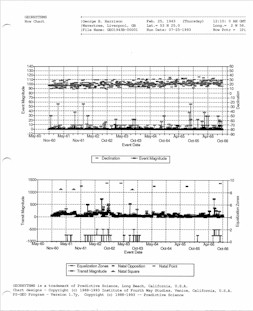
Now Chart Sample | The NOW Chart is a graphical representation of numeric data which depict events occurring at the time of, or generated as a result of close contact Transits against the backdrop of our inner strengths/weaknesses. When we consider the impact of Transits we first review the type of structure that is being activated (adaptive, resistive or combining), the relative strengths of the associated structures and the magnitude of the Fundamental and Transiting points involved. The NOW Chart is mapped against a specific time period ranging from as short as short as one week up a length of two years per page. Multiple pages can be arranged in a sequence to gain both a general as well as a specific view of the subject's experience over significant periods of time. The NOW Chart graph depicts the numeric data in the following ways; |